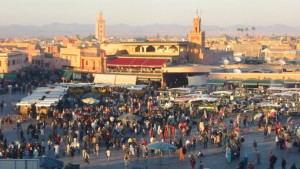
Morocco’s 10th Tourism Convention took place in Marrakesh on Nov. 30, presided over by no less than King Mohammed VI himself, and with an audience of some 3,000 Moroccan and international tourism professionals in attendance. Yassir Znagui, Morocco’s Minister of Tourism and Artisans, presented the keynote address of the convention, entitled Vision 2020, with a view toward the next 10 years of Morocco’s objective of increasing its visibility as one of the world’s major tourism destinations.
It is currently 25th on that list; by 2020 it aims to be 10th—a goal that seems all but certain to take place.
With its largely mountainous topography, Morocco nevertheless presents visitors with an incredibly diverse number of opportunities to experience in a remarkably short period of time.
In the span of one week, for example, one can sleep in a tent on the edge of the Sahara desert; inhale sea breezes in ancient Portugese ports along the Atlantic Ocean; lie on the sands of Mediterranean beaches; and wander through a dazzling array of exotic cities ranging from Marrakesh to Fez to Tangier.
Ten years ago, when Vision 2010 was launched, it provided a launch pad for future growth and sustainable development and management of the environment, since the country has always been—and continues to be—deeply sensitive to the preservation of its historical elements, even as new hotels, resorts, and housing communities are built.
The aim of Vision 2020, Mr. Znagui emphasized, is to make Morocco one of the 10 top destinations in the world, with an investment of nearly 177 billion dirhams ($20 billion) in the hope of doubling the number of tourists, increasing tourism revenue, and creating 147,000 new jobs in the sector by 2020. The overall goal is to double the size of the tourism sector and triple the number of national tourists over the course of the next decade.
An All-Encompassing Vision
Morocco’s development of new tourism goals covers virtually every area of the country, while adding eight new tourism locations to the north along the Mediterranean coast; in the Central Atlantic; in Central Morocco; in Marrakesh Atlantic, the Atlas Mountains and their valleys, the Sahara Atlantic and the Grand South Atlantic. The emphasis will be on quality tourism and staff training. A further 200,000 beds will be created.
Morocco’s new vision for 2020 rests on five basic principles: building on the achievements of Vision 2010; moving forward to a more integrated form of territorial improvement; making the most of the country’s wide variety of resources by responding to the demands of the most promising markets; remedying the industry’s persistent structural weaknesses; and placing sustainable development at the heart of its strategy.
Given the magnificence of its history, the beauty of its architecture both old and new, its world-famed cuisine, and its local color and customs, Morocco justifiably views tourism as a powerful tool for promoting itself abroad, strengthening its links with Europe, showcasing a Kingdom—led by a very young King—with a long history and a rich heritage, urging visitors to interact with its friendly and welcoming people, and enacting a smooth transition from an ancient past into a confident future,clearly establishing itself as one of the rising stars of international tourism.
Moroccan National Tourist Office, www.visitmorocco.com
